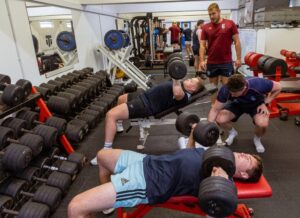In recent years It has become popular in Rugby the use of a wrestling coach or judo coach in a pre season with the thinking of utilizing the grappling techniques to improve fitness and toughness and some cross over into rugby, I’m not saying this is a bad thing nor is it effective, but I believe there is a better way that is more aligned to what players actually do in the sport, Enter the use of Combat Conditioning.
Combat Conditioning is not a martial art, although some techniques have been taken from or adapted from a martial art or combat sport to form a series of techniques and drills and movements to enhance your athlete’s physical and mental performance.
I was introduced to Combat Conditioning by a great friend and Mentor of mine Craig White over 8 Years ago when I worked in English Rugby Super League, Which is known for its big hits and multiple high speed collisions, Immediately I recognized that through the use of Combat conditioning, I could effectively, efficiently and safely improve the on field performance of the team in a time efficient and controllable manor and it yielded massive positive results. Later in my Career in Rugby union, XV’s and 7’s I have been highly sought after mostly due to my ability to utilize this skill set, to which I believe led to my success in improving on field performance with teams such as Georgia Rugby union, who are renowned for there Physical ability on the pitch.
A progressive Combat conditioning Pathway is often the most overlooked missing link in many rugby programs, yet the Combat situations make up a large part of the game of rugby.
So what is Combat Conditioning?
Combat Conditioning is the physical and mental preparation for the chaotic collision based events of the game of rugby, through various drills and techniques,
Acts as a BRIDGE between the gym and field by teaching the player to utilize their strength, power, agility and work capacity and transfer this into on field Rugby specific performance rather than being a robotic gym rat.
- Specific non-linear strength training for the whole body
- Increasing combat training movement vocabulary will help to reduce injuries
- Improved joint range of motion
- Improved whole body proprioception
- Strength work with decision making
- Has a direct transfer to Rugby performance
- Enhances confidence during rehab
- Maintenance of fitness during lower limb rehab
- Improved collision and floor based agility to aid being more effective within the game
- Enhances player rapport
- Enhances mental toughness and builds confidence
- Fun
- Improved awareness of your own body
- Improved awareness of other body shapes and sizes
- Increases testosterone production
- Youth players can be pushed to extreme levels, which they cannot in a gym setting
- One on One combat is unique and cannot be replicated in the gym.
The number one benefit of Combat Conditioning is preparation for most fatiguing element of the game; Collision.
Collision: the king of fatigue.
In rugby union there can be over 250 contact situations per game, not just with an other person or contact with the floor, consider for a moment the Ruck, mauls scrums, tackling being tackled, even scoring a try! The aim of these situations is to always achieve the most successful outcome for yourself and your team, therefore the ability and skill to dominate your opponent by understanding the positions where you are strong and with efficient use and manipulation of movement and energy, will clearly influence the outcome of the combat situation and the outcome of that play or even the game.
Why are collisions so fatiguing!
- Uses a different energy system that puts more demand on the body
- Maximum effort is always applied on each collision and impact, under fatigue
- Maximum speed is nearly always applied, under fatigue
- Maximum muscular recruitment is achieved in each collision
- Each collision is a fearful competition for the ball (Rugby Union)
- The Fear Factor increases the demand on the bodies mental and physiological systems
- Heart Rates are higher during combat work when compared to isolated running
- Teams that dominate the breakdown often win the game (Rugby Union)
- Teams that dominate the scrum often win the game (Rugby Union)
- Teams that dominate the advantage line often win the game (Rugby League)
- There can be over 50 collisions per player in Rugby League
- There can be over 70 collisions per player in Rugby Union
Take out the collisions and rugby is an easy game!
Where and when to use Combat Conditioning?
For me personally, I program Combat conditioning in my programs all year round for maximal benefits, but as a good rule of thumb here are some key times to get the most out of utilizing Combat conditioning in your program:
- Warm Ups
- As part of a functional pre season base
- Combined with running drills
- In mid and late stages of rehabilitation
- For players who may lack ‘contact’ during games
- Subs post game Sessions
- In Periods where Mental Toughness and Focus are Required
- Pre Season Progressive Training
- As a progressive short and long term training plan for school children and youths
- To fast track senior player who entered the game late
- Endurance, Strength, Speed, and Agility Sessions
- For players with lower limb issues who need to maintain fitness
- Return to play protocols
- For players with body composition issues who need extra, high intensity work
- Field based Circuits
- Combined with Gym Circuits
- Combined with Rugby Training
- Contact progressions
- Combined with Conditioning Games the list is endless you are only limited by your own creativity.
Golden Rules to implementing Combat Conditioning
- Safety is the number 1 priority of your drills
- Do not make drills and combat sessions too technically demanding
- Always use progressions from basic, slow, and light to advanced, quick, and intense
- Analyze the collision/combat content of your overall rugby program before implementing any combat training
- Know the rules of the game and the relevance of your drills
- Know the tactics of the coach and his game plan
- Always consult with the technical coaches before doing any combat drills
- You must learn the drills perfectly yourself before implementation
- Show the coaches what you are going to do, don’t tell them what you are going to do
Types of Combat Conditioning 
Individual and 1v1 1v2
Mobility/ agility
Slaps and taps
Neck & Core work
Partner Gym/ pitch
Lifts, carries and holds
Pulling
Pummeling
Striking
Drive outs
Tire drills
Tackle bag drills
Jackel/Poach drills (rugby union)
Takedowns
Escapes
Floor Skills & ground based agility
Drags and Crawls
Falls landings and rolls
Get ups and / or combinations of all the above
Get use the guidelines above and get creative.
Any further questions I will be happy to answer, have a go let me know how you get on.
RR: Thanks Ryan great article. To learn more about Ryan checkout the podcast we did with him here!







